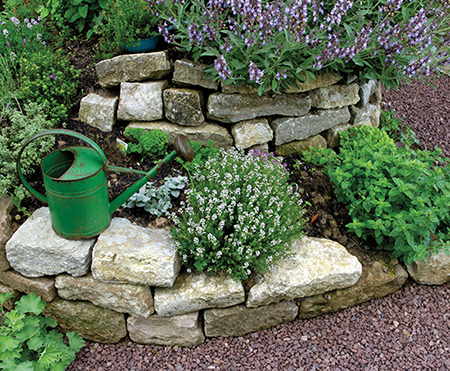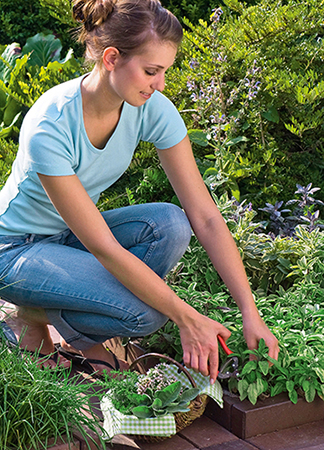Herb gardens
Herbs were once a standard feature in a kitchen garden, grown for both flavoring and medicinal properties. A ready supply of fresh herbs is just as useful today—home-grown plants look good in the garden and are often tastier and cheaper than store-bought ones.
Most herbs like a sunny area with loose soil, although some, such as parsley and chervil, do best in partial shade. Raised spiral herb gardens built up with rocks and soil have been used for many generations to get maximum productivity out of small spaces. They also tend to suffer from fewer pests and the garden is accessible from all sides. The basic design calls for a spiral or layer of rocks, enclosing soil in which many species of herbs can be planted. The rocks warm the soil and the design allows for a wide variety of soil conditions.
GOOD TO KNOW 
Fertilizing in moderation yields better taste
Only natural fertilizers should be used in an herb bed, if any are used at all. The plants lose flavor if they get too much of a good thing. A little compost worked into the soil is ideal, plus weekly liquid fertilizing.
CREATING an herb spiral
• Plant an herb spiral in spring or autumn on at least 32 square feet (3 m2). Sketch the shape in advance.
• Add a small pool about 30 inches (80 cm) deep at the beginning of the spiral. Line it with pond liner and reinforce with stones.
• Dig out the remainder of the herb bed to the depth of a shovel and fill it with an 80:20 mixture of soil and well-rotted compost or manure. Create a small mound about 3 feet (1 m) high in the center of the bed and reinforce it in a spiral shape with stones.
• Fill the upward-spiraling bed with different types of soils to create the following areas.
1 In and around the pond at the base of the spiral, the loamy soil should stay moist. Watercress and water mint will thrive here.
2 The next level provides a sunny, compost-rich moist zone. Plant basil, chervil, dill, garlic mustard, parsley, peppermint, sorrel, chives, garlic chives and wild arugula.
3 The middle sector may be partly shaded, with rather dry humus soil creating the best conditions for fennel, cilantro, lovage, tarragon, oregano, marigold and hyssop.
4 Plant warm-climate herbs in the dry zone at the top of the spiral. This is where savory, lavender, marjoram, sage and thyme grow best. The soil is permeable and water will drain down naturally to the lower levels where you have planted herbs that need more moisture.

Plants find ideal conditions in the limited space of an herb spiral, and more plants can fit in a small area.
MAINTAINING the herb garden
• Give tough-leaved herbs such as bay and rosemary only a little water—they don’t usually require much.
• Make sure water is able to run off effectively through a drainage layer of gravel or topsoil.
• Hoe the ground between herbs regularly to keep it loose and let the water soak in.
• If the pH of the soil is less than 5, add garden lime to give herbs an additional source of calcium and magnesium. Varieties that thrive with its help include savory, tarragon, caraway, marjoram, mint, parsley, rosemary, chives and thyme.
• Plant a hedge of boxwood, lavender or hyssop to protect herbs from wind and frost.
• Cut back bushy herbs like lavender and thyme in the autumn to prevent frost damage.
• Keep herbs from spreading out too much by cutting them regularly. Thin out perennials like oregano each autumn.
• Plant mint and lemon balm in pots to restrict their growth. They can form strong runners that quickly take over the entire bed.
• Seed annual herbs in a different location every year. This form of herbal crop rotation will help to keep the soil from becoming too depleted.
• Many herbs need room: Lovage and fennel have large roots that can damage adjacent plants.

Pick leaves and flowers by hand, but cut off tougher stems with gardening scissors.
HARVESTING herbs and seeds
• Gather herbs and seeds in late morning for the best flavor.
• Collect the seeds of dill, fennel, cilantro and lovage when they turn from green to brown.
• Dig up garlic before plants flower and before the leaves dry up—that way the bulbs keep better.
• Harvest most herbs before they flower, otherwise their flavor fades or (in the case of sage) disappears. Lavender, thyme and oregano can, however, be harvested at flowering time.
• Pick lemon balm in the afternoon when the leaves develop their greatest intensity before, or just after, the flowers open.
HERBS CAN BE GROWN in pots ON THE kitchen WINDOWSILL.




